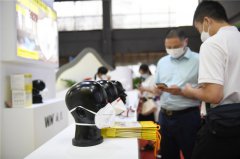Reporter's driverless van ride: Cool tech, freaky turns
Waymo recently launched the United States' first large-scale ride-hailing service with autonomous vehicles that operate at roadway speeds and don’t have human backup drivers
May 20, 2021, 11:00 PM
5 min read
Share to FacebookShare to TwitterEmail this articleA Waymo minivan moves along a city street as an empty driver's seat and a moving steering wheel drive passengers during an autonomous vehicle ride, as passengers view a detailed viewing screen, Wednesday, April 7, 2021, in Chandler, Ariz. Waymo, a unit of Google parent Alphabet Inc., is one of several companies testing driverless vehicles in the U.S. But it's the first offering lifts to the public with no humans at the wheel who can take over in sticky situations. (AP Photo/Ross D. Franklin)
CHANDLER, Ariz. -- The annoyed shopper paced around and knocked on the windows of a minivan blocking him from leaving his Costco parking spot. He didn’t seem to notice, or care, that there was no one inside.
A colleague and I had called for the Waymo ride — our first in a fully driverless vehicle — and quickly encountered a hiccup: figuring out how to tell it to meet us at the curb.
We ended up spotting the minivan across the bustling parking lot, and hurried over. As we pulled away, the shopper raised his arm and extended his middle finger.
Welcome to the United States’ first large-scale ride-hailing service with no backup drivers, which Waymo recently launched in suburban Phoenix.
An AP photographer and I took it for a spin and discovered some impressive technology. Waymo’s minivans skillfully adhere to traffic laws and can detect people, vehicles and objects from several hundred yards away.
But amid the advances lurk challenges that developers face as they race to bring autonomous cars to the masses: adapting the machinery to human behavior — and getting passengers to feel at ease without a person behind the wheel.
“The technology is great, but the experience isn’t there yet,” said Andrew Maynard, a professor at Arizona State University’s College of Global Futures who studies the social and ethical aspects of autonomous vehicles and other emerging technologies.
Waymo, a unit of Google parent Alphabet Inc., is one of several companies testing driverless vehicles in the U.S. While there are some low-speed driverless shuttle services in operation, Waymo is the first offering lifts to the public at roadway speeds with no human in the driver’s seat who can take over in sticky situations.
During our rides, the minivans slowed for speed bumps and carried out a textbook right-on-red turn. Most impressive was a careful maneuver at a green light where a woman with a walker stood dangerously close to the corner.
But customers in crowded parking lots might find it hard to pinpoint pickup locations without drivers who can call, text or simply watch for them.
A Waymo minivan also made an aggressive turn at a green light that we would have never taken. Another failed to go the requested location, dropping us off about a four-minute walk away.
And watching the wheel turn by itself was, well, eerie.
The company said it is listening closely to customer feedback and acknowledges it needs to improve passenger pickups. It's also working to set the proper expectations with riders and has launched a campaign that provides tips.
Automakers and tech companies were moving quickly to put self-driving vehicles in action in 2018, but a fatal crash involving an Uber test vehicle in Tempe slowed development.
Only recently did the industry show signs of recovery. Still, most experts believe there won’t be widespread use for another five years or so, and autonomous vehicles won’t be in every major city until at least late this decade.
Waymo started offering autonomous rides to a limited number of customers during 2019 in an early testing program in Arizona. Last fall, it opened its ride-hailing program to anyone seeking a ride within its 50-square-mile (129-square-kilometer) service area covering parts of Chandler, Tempe and Mesa.








